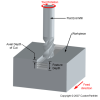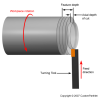A
Acetal
Acetal resins, whose chemical name is polyoxymethylene, are formed from the polymerization of formaldehyde. Acetals tend to have a high degree of crystallinity, giving them superior strength and stiffness compared with other thermoplastics, while retaining good toughness at low temperatures. Acetals are known for their high strength, fatigue and corrosion resistance, surface hardness, lubricity, and resilience.
Acrylic
Acrylic resins are widely known for their superior impact resistance and clarity. Acrylates and methacrylates comprise the two main groups of acrylics, which enjoy widespread use in aerospace, automotive and optical applications.
Acrylonitrile Butadiene Styrene (ABS)
Introduced in the late 1940s ABS has a wide range of good properties. It's very stiff, tough, thermal and chemically resistant, it is easy to process and has an excellent surface appearance. ABS is used in many impact-resistant applications from motorcycle fairings to lawn mower housings.
Acrylonitrile Chlorinated PE-styrene
Like ABS, it is a terpolymer, but of acrylinitrile and chlorinated polystyrene, and has better flame-retardency and weatherability than ABS.
Acrylonitrile Styrene Acrylate (ASA)
ASA is produced either by a patented, proprietary process or by graft process. ASA has superior weatherability compared with ABS and because of an absence of double bonds resists yellowing and embrittlement better than other polymers.
Additional costs per operation
The total cost of any material, components, or equipment used in a single operation. The additional cost per part is equal to these costs per operation amortized over the number of parts per operation.
Additive
A substance that is added to the raw material used in a process in order to alter some material property. Examples of additives include colorants, flame retardants, and UV protectants. The additives ratio describes the weight of additives that may be added relative to the weight of raw material.
AISI
The American Iron and Steel Institute.
AISI Steels
Steel designations defined by of the American Iron and Steel Institute. AISI carbon and alloy steels are essentially the same as those designated by the Society of Automotive Engineers (SAE). The AISI system is more comprehensive than the SAE in that letters precede the alloy number indicating the manufacturing method: A represents basic open-hearth alloy steel, B acid Bessemer carbon steel, C basic open-hearth carbon steel, CB either acid Bessemer or basic open-hearth carbon steel, E electric furnace alloy steel.
Alloy Steel
Steels containing alloying elements and with qualities superior to those of carbon steels. An alloy steel is defined as meeting one or more of the following conditions: having a manganese content greater than 1.65%, a silicon content greater than 0.5%, a copper content greater than 0.6%, or specified minimum quantities of chromium, molybdenum, nickel, tungsten, or vanadium. Alloys with a total of less than 5% of such elements are considered low alloy steels. Alloys with more than 11% chromium are generally considered stainless steels. Most alloy steel is medium- or high-carbon steel.
Aluminum
Chemical symbol Al. Element No. 13 on the periodic chart. Aluminum is a white-silver metal with an atomic weight 26.97, a melting point of 660°C (1220 °F), and a boiling point of approximately 2270°C (4118 °F). It is stable against normal atmospheric corrosion, but attacked by both acids and alkalis. Aluminum is light weight, ductile, malleable, and conducts electricity with very little resistance. Aluminum is often alloyed with other metals to improve its tensile strength and resistance to acids and alkalis. Pure aluminum is refined from alumina, a common oxide found in bauxite ore. Aluminum is second only to steel in consumption. Aluminum is heavily used in the transportation, packaging, building, electronics industries. Its principle uses in steel making include: deoxidation, restricting grain growth (by forming dispersed oxides or nitrides), and as an alloying element in nitriding steel.
ASTM
The American Society for Testing Materials.
Automatic tool changer
A device that stores several tools, each in its own pocket or tool holder, and can automatically move the required tool into position. In a milling machine, this device removes the tool from the spindle, places it back in the correct pocket, and inserts a new tool into the spindle. In a turning machine, this device (known as a turret) rotates the required tool into position and continues to hold it during the cut.
Automatic tool change time
The time required for an automatic tool changer to position a new tool. In a milling machine, this includes the time to stop and orient the spindle, remove the current tool, insert the new tool, and start the spindle again. In a turning machine, this time describes the turret rotating to a new tool position.
Axial depth of cut
The depth of the tool along its axis in the workpiece as it makes a cut. In turning, a facing operation has an axial depth of cut relative to the workpiece axis. A large axial depth of cut will require a low feed rate, or else it will result in a high load on the tool and reduce the tool life. Therefore, a feature is typically machined in several passes as the tool moves to the specified axial depth of cut for each pass.

End milling (Milling machine) |

Facing (Turning machine) |
Back to top

